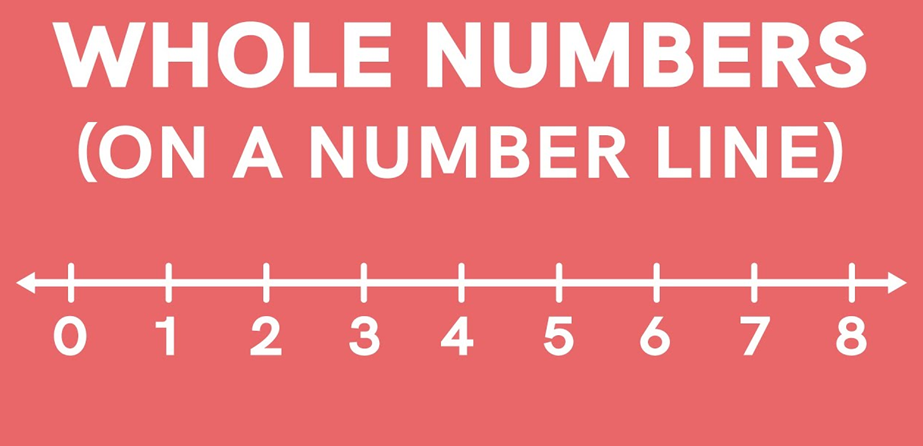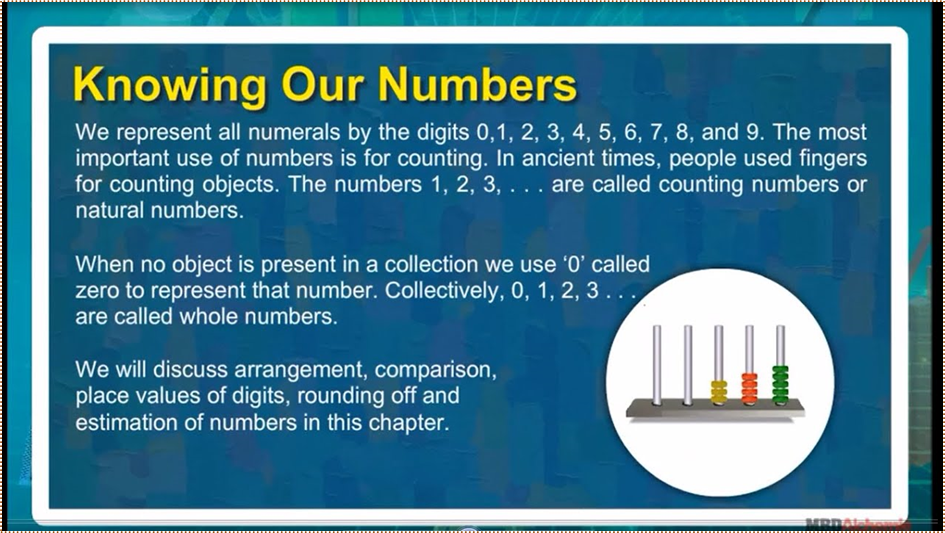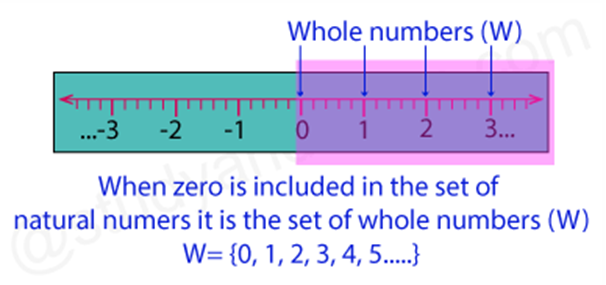1. Introduction to The Whole Numbers
- Books Name
- Class 6 Mathematics Book
- Publication
- ReginaTagebücher
- Course
- CBSE Class 6
- Subject
- Mathmatics
Chapter 2
Whole Numbers
What are whole Numbers?
Let’s begin with natural Numbers.

When we begin to count we naturally use counting Numbers {1, 2, 3, 4.}. Hence, Natural Numbers are the numbers starting from number 1 to infinity
We represent natural Numbers by ‘N’.
Or we can say N = {1, 2, 3, 4.} (i.e. 1 to infinity)
For Every natural number, there is a predecessor and a successor.
For Example: Predecessor of 2 is 1 and
Successor of 2 is 3.
The set of natural Numbers along with zero are called whole Numbers. The set of Whole Numbers without decimal or fractional Numbers.
We represent whole Numbers by ‘W’.
Or we can say W = {0, 1, 2, 3, 4.} (i.e. 0 to Infinity)
Important Note
1. We can get successor of a whole number by adding 1 to the given whole number.
E.g. 9
Then, number is 9.
Successor = 9+ 1 = 10
every whole number has its successor.
2. We can get predecessor of whole number by subtract 1 from given whole number.
Illustration 23
Then, number is 23
Precursor = 23-1 = 22
3. Zero has no predecessor.
4. The lowest whole number is‘0’.
5. There's no largest number in set of whole Numbers.
6. Every whole number without ‘zero’ is a natural number
2. Properties and Patterns of Whole Numbers
- Books Name
- Class 6 Mathematics Book
- Publication
- ReginaTagebücher
- Course
- CBSE Class 6
- Subject
- Mathmatics
Properties and patterns of whole Numbers
Properties of Whole Numbers

1. Closure Property
2. Associative Property
3 Commutative Property
4. Distributive Property

1.Closure Property of Whole Numbers
This property tells us that when whole number is operated on "Addition and multiplication” their answer is always in Whole Number.
This property does not be same as on whole numbers in the while doing division and subtraction.
For example: Two whole numbers subtracted then answer will not be whole number, 2 and 4 are whole numbers, but 2 - 4 = -2, is not a whole number. Same in the case of division, 2/4 is not defined
Associative Property of Whole Numbers
This property tells us that "The answer of the sum and the product of whole numbers remain the same, if the numbers are three whole numbers
Example 1: (1+2)+3 = 1+(2+3) because,
(1+2)+3 = 3+3 = 6
1+(2+3) = 1+5 = 6
Example 2: (1×2) × 3 = 1 × (2×3) because,
(1×2) × 3 = 2 × 3 = 6
1 × (2×3) = 1 × 6 = 6
This property of whole numbers does not same for division and subtraction operations.
For example, 4, 5, and 6 are whole numbers, but 4 - (5 - 6) = 4 - (-1) = 5 and (4 - 5) - 6 = - 1 - 6 = -7. So, 5 ≠ 7.
The same is with the division where 9 ÷ (6 ÷ 3) ≠ (6 ÷ 3) ÷ 9.
Commutative Property of Whole Numbers
“After interchanging the order of the numbers, the sum and the product of two whole numbers always are the same number”.
Example 1: 4+5 = 5+4 because,
4+5 = 9
5+4 = 9
Example 2: 4×2 = 2×4 because,
4×2 = 8
2×4 = 8
the commutative property of whole numbers does not always be the same for on division and subtraction.
Distributive Property of Whole Numbers
The distributive property of multiply and sum is
A× (b+c) = a×b+a×c.
Example 1: 3× (2+5) = 3×2+3×5 because,
3× (2+5) = 3×7 = 21
3×2+3×5 = 6+15 = 21
the distributive property of multiply and subtract is a× (b−c) =a×b−a×c.
Example 2: 3× (5−2) = 3×5−3×2 as,
3× (5−2) = 3×3 = 9
3×5-3×2 = 15-6 = 9
Patterns in whole numbers
Patterns are defined as the sequence that follows a defined sequence or patterns

Here the numbers are 11, 17, 23, 29, 35, 41, 47, and 53. The
The numbers are increasing by count of 6 every time.
Using Dots Number Patterns
Every whole number is defined in the form of dots and to find the pattern numbers are arranged in the dots representation. These representations are A rectangle, A square, A triangle

 Param Publication
Param Publication
 ReginaTagebücher
ReginaTagebücher
